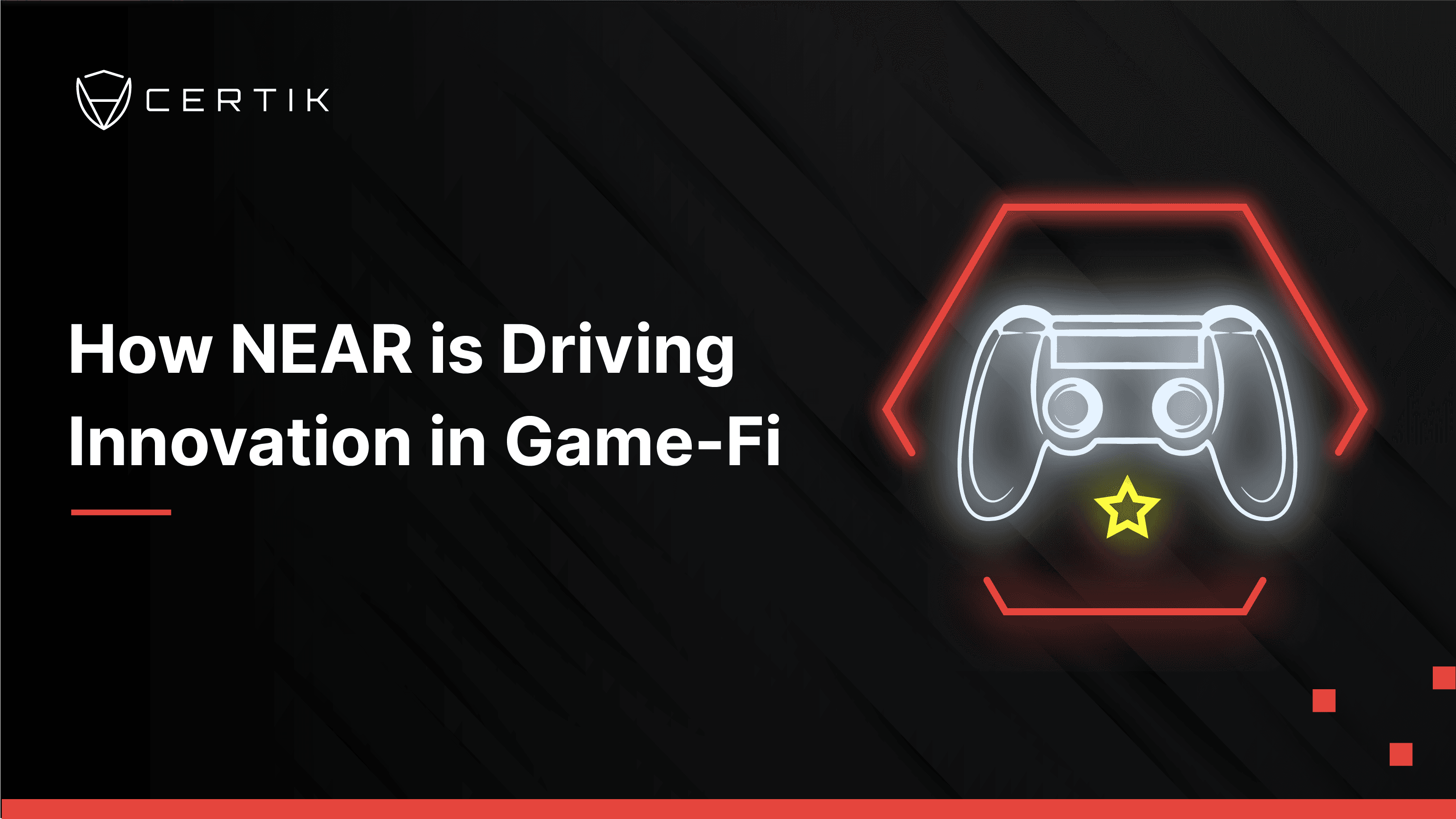How NEAR is Driving Innovation in Game-Fi

Game-fi is increasingly touted as a key on-ramp for initiating new users into the web3 ecosystem. With such an avid gaming community hungry for new ways to play and interact, game-fi offers an open door into not only new games, but also new forms of gaming.
NEAR is leading the way in this sector by providing a technology that is uniquely suited to providing game-fi developers the platform they need to create. This article will run through why game-fi is set to be a pillar of the web3 ecosystem, how NEAR’s technology is geared to support it, and the importance of NEAR smart-contract audits in securing game-fi for the future.
Gaming in the Web3 Ecosystem
Gaming is one of the industries most impacted by the seismic force of blockchain and decentralization, and NEAR protocol is positioned as one of the leading platforms for developers to build the future of gaming.
For those that don’t know, game-fi refers to any game that is built on the blockchain. Whilst this may sound underwhelming, being built on the blockchain allows for a host of radical new functionalities and forms in gaming previously unimaginable. So, imagine an open-world online role-playing game in which the coins and assets you earn translate into real-world assets. Imagine then transferring these assets between games and trading them in external marketplaces as part of rich economies that expand far beyond single games.
These are just some of the possibilities that blockchain creates in gaming. To understand how it does this, we have to go back to one of the fundamental principles of blockchain technology: decentralization.
By removing a centralized database and storing all transactions and data on a decentralized ledger, any ownership or assets connected to an individual player are made immutable and transparent on the blockchain. These assets are then tokenized on the blockchain in the form of NFTs, which can represent anything, from an exclusive weapon, to a hard-to-find costume, even a plot of land.
What’s more, game-fi has flipped traditional pay-to-play gaming models, creating worlds where players are incentivized to play by a play-to-earn model. In this model, players compete to complete tasks, battle other players, or progress through various game levels. In return they are rewarded with in-game assets which can then be traded on NFT marketplaces. So, imagine spending the time to win a rare and lucrative in-game item, and then selling that item to a keen collector.
We have barely scratched the service of the kinds of radical new games and online realities that are made possible with game-fi. Trying to sum up the possibilities would be like summing up how online gaming would revolutionize campaign games, or how portable gaming would revolutionize arcade games. In short, game-fi constitutes a new epoch of gaming, and it is up to the creativity and ingenuity of a host of new programmers, developers, artists and storytellers to show us what is possible with it.
To make that happen, game-fi developers need a network that is scalable, accessible, and usable. To that end, NEAR protocol has become a natural choice for some developers looking for the kind of scalability that enables mass adoption.
Scalability
One of the ways it does this is through its innovative sharding mechanism Nightshade, which works to create a fully sharded network that invites a diverse community of validators to take part in securing the blockchain.
By drastically lowering the hardware requirements to run a node on the network, NEAR’s sharding mechanism means that NEAR projects benefit from the security created by increased decentralization.
Stake Farming
NEAR protocol also works to foster cohesion between its game-fi projects and validator community through the novel practice of stake farming. With stake farming, game-fi games and other projects built on NEAR are given the opportunity to partner with validators to offer more than one token to delegators in securing the network.
This inspired move works to align the interests of validators and NEAR projects by giving validators the chance to earn more capital, whilst simultaneously ensuring that new NEAR projects have the chance to take part in network security.
For game-fi games, stake farming provides a way of gaining exposure to more delegators (token holders who want to secure the network without running validation hardware), and consequently helps increase drive adoption of the game.
Accessibility
As a new and growing industry, one of the big hurdles for the growth of game-fi is opening the industry up to developers and programmers unfamiliar with web3. One of the ways NEAR does this is through its launch of its Javascript SDK.
Whilst popular programming languages like Rust and Solidity have driven innovation in the web3 ecosystem, the fact remains that the majority of game developers are unfamiliar with them, and are consequently locked out of game-fi.
NEAR’s Javascript SDK takes a bold step towards resolving this, as it invites legacy game developers to start innovating and experimenting in the space. This is a perfect example of NEAR’s mission to foster usability in action, and highlights how usability is essential to growing an ecosystem, and driving adoption.
Human Guild
Perhaps the best example of how NEAR is fostering the future of gaming, is by taking a look at a collective of programmers and game developers working with NEAR to explore the game-fi.
They are called Human Guild: an open group of founders and creators committed to exploring the possibilities of game-fi in the NEAR ecosystem. Founded by NEAR core team members Aliaksandr (Sasha) Hudzilin and Vlad Grichina, Human Guild is dedicated to pushing the limits of the gaming form, and ensuring that developers get remunerated for doing it.
Speaking on the project, Sasha said, “We do not want to fit old games into new models, we want to create new kinds of games and explore what the possibilities of gaming are in web3.”
Unsurprisingly, Human Guild has chosen NEAR as the space in which they will create, explore and innovate, no doubt making use of the scalability and usability that NEAR affords.
OP Games
The gaming company, OP games has also chosen to develop on NEAR, and is another example of how NEAR is a clear choice for game developers looking to work in web3.
OP Games has been leading the way in creating some of the most popular games in the web3 ecosystem, and is keen to explore the full functionalities offered by building on NEAR. One way it does this is by enabling players to connect their NEAR wallets to the Arcadia gaming platform, which in turn allows the gaming platform to offer $NEAR as a buy-in and payout for winnings.
While OP Games eventually sees itself as being blockchain agnostic, NEAR’s technical advantages made it a clear choice for its current stage of development.
NEAR Smart-Contract Audits for Game-Fi
Given the amount of value locked into NEAR’s game-fi ecosystem, it is vital that any game-fi project looking to build on NEAR first seeks out a NEAR smart-contract audit.
CertiK’s NEAR smart-contract audit applies the industry best in auditing technology to analyze, identify, and remediate any vulnerabilities and attack vectors in the client’s smart-contracts.
Deploying the cutting edge in AI technology, alongside meticulous, line-by-line analysis from leading computer science experts, CertiK’s NEAR smart-contract audit provides game-fi projects with the best possible footing to flourish within the NEAR ecosystem.
Within web3, game-fi applications typically intersect with numerous other web3 technologies, such as the metaverse, cryptocurrencies, and DeFi trading platforms. As such, it is essential that a NEAR smart-contract audit that is auditing a game-fi application is equipped to deal with the specific vulnerabilities that these intersections can bring.
Honed through partnerships with projects from across the NEAR ecosystem, CertiK’s NEAR smart-contract audit has a nuanced understanding of the NEAR’s architecture and the needs of projects that build on it.
CertiK is also the first to offer a NEAR smart-contract audit with KYC verification for project teams, which works to foster trust and accountability between projects and their communities.
Not only this, CertiK provides a range of security tools beyond its NEAR smart-contract audit that are designed to provide NEAR projects the best possible security after they launch. The blockchain analytics tools Skynet and SkyTrace equip project teams with an unparalleled view of their on-chain activity, which in turn helps them anticipate and respond to attack.
CertiK has also recently expanded its security toolkit to provide a unique bug bounty service, which works alongside the NEAR smart-contract audit to ensure that a NEAR project has the best possible security posture.




